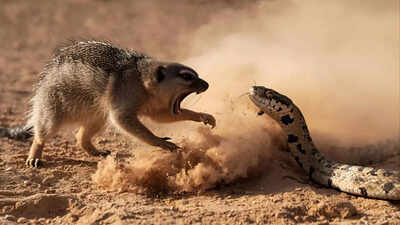ARTICLE AD BOX

From Rudyard Kipling’s Rikki-Tikki-Tavi to real-life wildlife encounters, tales of mongooses bravely confronting venomous snakes have captured imaginations for generations.
While these stories seem like folklore, the rivalry between snakes and mongooses has a firm basis in science. A study by the Weizmann Institute of Science revealed that mongooses have a unique mutation in their acetylcholine receptors that reduces the binding of snake neurotoxins, making them resistant to venom that would be deadly to other animals.This adaptation, combined with their agility and quick reflexes, allows mongooses to survive encounters with venomous snakes and often emerge victorious.
The snake and mongoose rivalry offers a fascinating look at evolution, predator-prey dynamics, and survival strategies in the wild. In this article, we explore how mongooses fight snakes, why snakes and mongooses are enemies, and what determines who wins in these natural duels.
How mongooses fight snakes effectively

The mongoose vs snake fight relies on a combination of physical traits and behavioral strategies. Mongooses have remarkable reflexes that allow them to dodge fast strikes, and their attack strategy usually focuses on biting the snake’s head or neck.
Thick fur and strong muscles protect them from minor bites, while sharp teeth enable quick, precise attacks. These traits help mongooses survive venomous snake encounters and frequently emerge as the victor in direct confrontations.
Snake strategies in the fight against mongooses

Despite the mongoose’s advantages, snakes have their own survival mechanisms. Venomous snakes use neurotoxins or hemotoxins to immobilize threats, while camouflage and stealth help them ambush prey or avoid detection.
Larger snakes can rely on size and strength to defend themselves. However, mongooses often outmaneuver snakes thanks to speed, agility, and venom resistance, giving them a higher success rate in many duels.
Observational insights from snake and mongoose encounters
Field studies suggest mongooses win roughly 70-80% of face-offs with snakes. Their reflexes, venom resistance, and targeted attacks contribute to these outcomes. The species of the snake, venom potency, and environmental factors such as terrain and visibility also influence the results, making each encounter unique.
Risks and limitations of the mongoose and snake fight
Mongooses are not invincible. Highly venomous snakes or well-timed strikes can be fatal. Environmental factors like terrain and visibility can affect the outcome, and mongooses can sustain injuries during confrontations. This shows that while mongooses have significant advantages, the snake and mongoose fight remains dangerous and unpredictable.
Evolutionary implications of the snake and mongoose rivalry

The ongoing snake vs mongoose rivalry is a textbook example of coevolution.
As snakes develop stronger venom or new defense strategies, mongooses evolve improved reflexes, tactical behaviors, and venom resistance. This evolutionary arms race drives the development of specialized traits in both species and highlights the complex dynamics of predator-prey interactions in nature.
Who usually wins the snake vs mongoose fight
Scientific evidence shows that mongooses generally have the upper hand in most encounters due to agility, venom resistance, and precise attack strategies.
Snakes can still win, particularly with highly venomous species, advantageous conditions, or surprise attacks. The outcome of the snake and mongoose fight depends on species, environment, and strategy.By studying this rivalry, we gain insight into evolution, survival tactics, and the balance of ecosystems. The snake and mongoose conflict remains one of nature’s most fascinating duels, showing how adaptation and strategy shape the interactions between predators and prey.Also read| Hidden deadly animals living near us and how to stay safe



.png)
.png)
.png)
















 1 hour ago
4
1 hour ago
4









 English (US) ·
English (US) ·